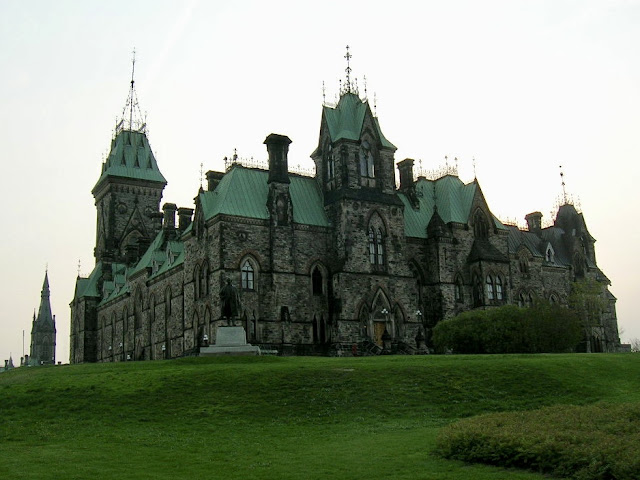Business travel took me to Ontario when the notion of Canada becoming the 51st state would have been inconceivable, even though the Republicans already had stolen the last presidential election in America. Visitors can see the very Gothic Peace Tower from almost anywhere in Ottawa.
It wasn't added to the other Parliament buildings--designed to evoke the architecture of European governance--until another tower, named for Queen Victoria but only half as tall, burned down in 1916, the year my mother was born.
The iconic tower also serves as a memorial to the men and women who lost their lives fighting for Canada before and after it gained independence from England in 1931. Their names appear in eight books whose pages are turned every day so the name of each individual will be on display at least once throughout the year.
A new Canadian flag has been flown atop the Peace Tower every day since 1998. Canadian citizens can request a retired maple leaf free of charge by adding their names to a decades-long waiting list. No doubt surging Canadian patriotism in the face of American belligerence has exponentially increased demand.
Ironically, the Canadian Parliament sits on a hill where the British military planned to erect a fortress to deter a possible American invasion after the War of 1812. At the time of its completion in 1876, the Dominion of Canada consisted of only six provinces: Ontario, Quebec, Nova Scotia, New Brunswick, Manitoba, British Columbia and Prince Edward Island. Today, elected representatives of ten provinces and three territories convene in this building. As a non-covetous American, I am proud to say that I have visited all but five!
Rarely have I stayed in a hotel as grand as the Chateau Laurier. Somebody else was paying, of course.
Parliament Hill overlooks the city and the Ottawa River, a tributary of the mighty St. Lawrence.
By the time I encountered Anishinaabe Scout in Major's Hill Park, Canada had begun to reckon with its colonial past. For nearly a century, he had been kneeling before a statue honoring Samuel de Champlain, the French trapper who founded Quebec City. No more. He's probably looking for fentanyl smugglers. Or invading Americans.
Would this clambering school group have been shocked to know that female historical figures lacked representation on Parliament Hill when they were born? "Women Are Persons Too!," dedicated just four years earlier, depicts five famous suffragists from Alberta. They appear to be discussing strategy over tea.
It's funny how history (and age!) changes your perspective. The Rideau Canal once provided a shipping lane between Montreal and Ottawa (then called Bytown). Note how it bends away from the United States border.
Once again, that's because Canadians feared the U.S. would try to take over the St. Lawrence River after the War of 1812, crippling their military's ability to re-supply.
The canal, which has 46 locks, has been in continuous operation since 1832, longer than any other in North America. It's a lot bigger and more impressive than the one in Seattle.
Today, people mostly boat or skate on the Rideau Canal. But now that everything old is new again, we'll see how much longer recreation trumps defense strategy.
My concerns at the time were far more parochial. I worked for a think tank at George Washington University called Ensuring Solutions To Alcohol Problems. English Canadians were not modeling good behavior on one of their capital's main streets!
I had enough down time to explore the neighborhood around my hotel which included both traditional housing
. . . and street art.
As much as I would have like to have seen Canadians skating on the Rideau Canal, I was glad to be visiting Ottawa in spring.
A festival in Major's Hill Park celebrated tulip season. This statue honors the first keeper of the canal.
Those are the twin spires of the Notre Dame Cathedral Basilica in the background.






















No comments:
Post a Comment